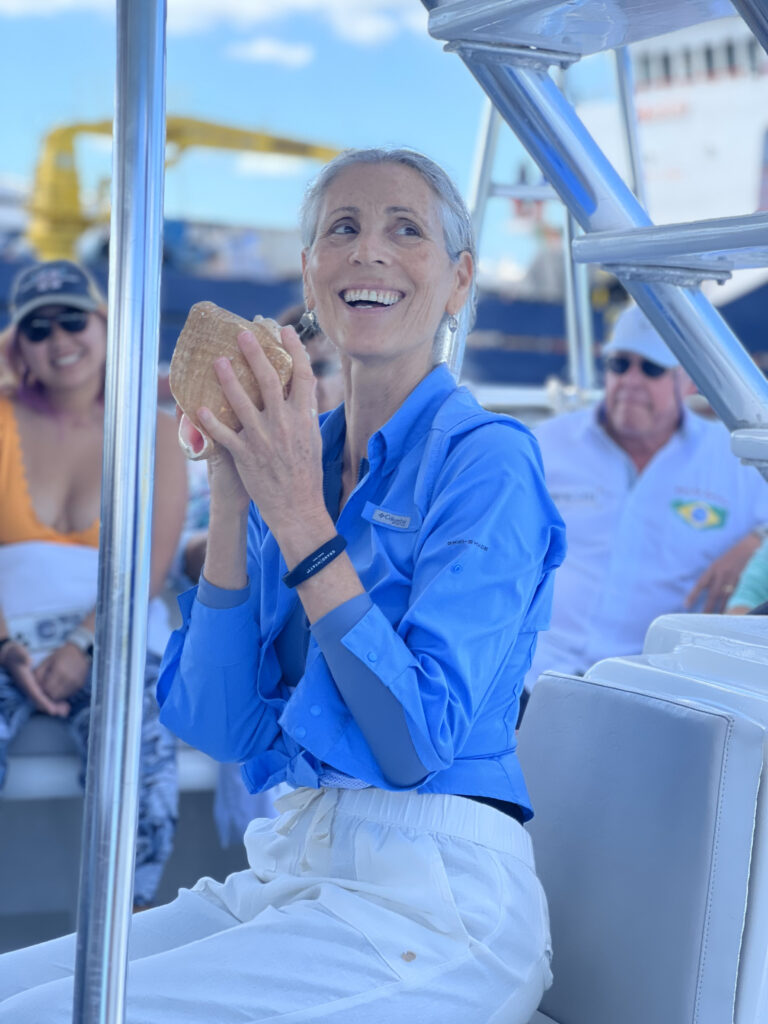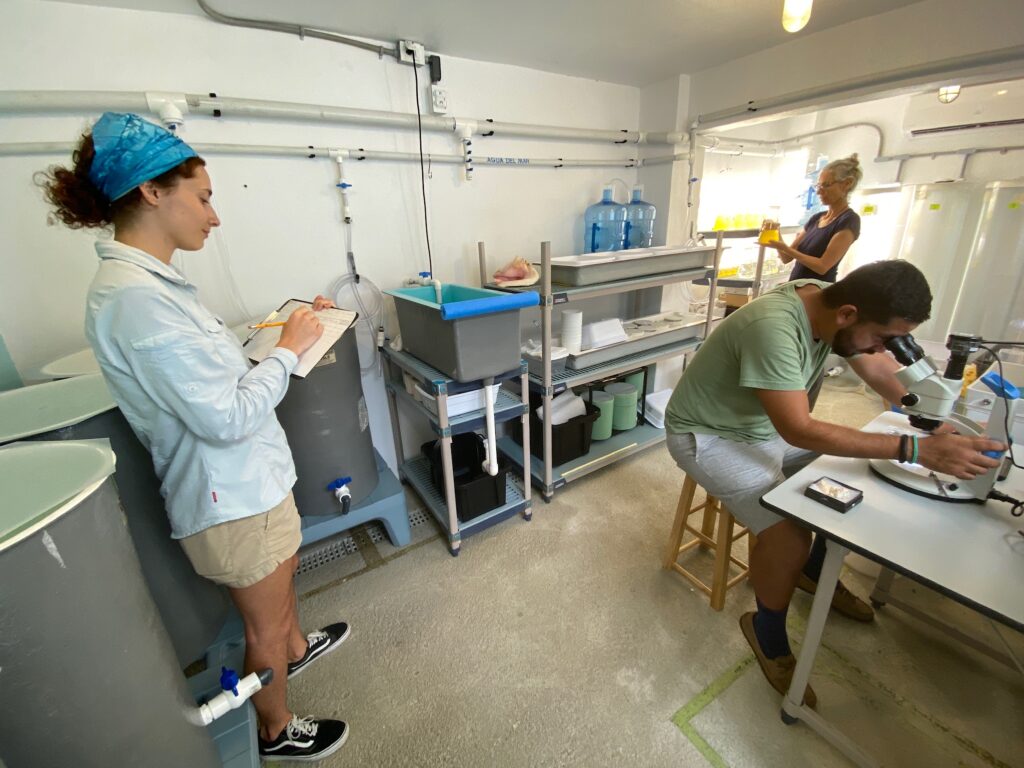By Bella Kubach, The Invading Sea
The following is a Q&A conducted with Megan Davis, Ph.D., a research professor at Florida Atlantic University Harbor Branch Oceanographic Institute. Davis is director of the Queen Conch Lab, which works toward restoring the queen conch population to benefit Caribbean communities culturally and economically, while also benefiting the marine environment. This interview has been edited for length and clarity.
Can you tell us a little bit about the Queen Conch Lab. What different projects are currently in progress?

We’re based at Harbor Branch, and our mission is to grow conch for the sake of the species, the ecosystem, the seagrass ecosystem and also for the people who depend on the fishery. In order to do that, we have a vision to have a conch farm in every Caribbean country. And not just a conch farm: a community-based conch farm where it’s run by the community so that they learn about the species that’s so important to the environment and to their livelihoods. We are currently in six locations, but there are two coming on.
I understand that you were gifted $2.8 million from the Builders Initiative to create a queen conch hatchery in Grand Bahama. How is that project moving along? What progress have you made?
We just finished our first year in partnership with Blue Action Lab. During that year, we did what you’d consider site development, where we’re going to put the mobile labs. There’s two mobile labs that are going to be shipped to Grand Bahama. They’ve been built, and they’re almost ready to be shipped. We built them here at Harbor Branch — we have a fabrication and a machine shop. We bought the trailers, and then we did all the inside work and made the laboratories inside.
Could you explain to us the difference between the work you’re doing in the mobile labs and the farms?
In order to be able to put conch farms in different parts of the Caribbean, we’ve been building these mobile laboratories because they’re portable. We can build the labs in them, and then they can be shipped to various sites.
But we do have a site in Puerto Rico that is a stationary site. It’s our first facility that we got involved with, and that was in 2019. We work with Conservación ConCiencia, which is a nonprofit conservation organization that is in Puerto Rico. We work directly with the fishing association in the Naguabo, and our facility is in the fishing association. We work with the fishermen, and we work with the conservation organization as well.
Why is the queen conch so important? What impact do they have on the environment?
The queen conch is a culturally important species. It’s very much an icon when you think about the Caribbean, and some places more than others, but the majority of the Caribbean has the queen conch and some sort of fisheries. Their livelihoods depend on it. Some communities are totally 100% there because of the queen conch. They wouldn’t exist if it hadn’t been for the species.
The species is a herbivore, and it lives in the seagrass beds. It also lives in other sandy areas as well. It’s very much a grazer, and it helps to clean the seagrass blades, which is really important for healthy seagrass beds.
How has climate change had an impact on the queen conch population?
One of the problems with climate change is that there’s stronger and more frequent storms. When there’s storms such as Hurricane Maria that came through Puerto Rico, all the very shallow areas where the nursery grounds are for the conch get buried. The conch get buried, and it takes a long time for the population to come back in that area.
You and your lab have learned how to culture queen conch pearls. What’s the significance of this?

Queen conch pearls are one of the few pearls that are still sold as wild pearls or natural pearls. I would say that 99% or more of the pearls that are on the market these days are cultured pearls, not for conch but for all other pearls that you see on the market. (In nature, there’s only 1 in 10,000 conch that have a pearl and out of those, usually there’s one of very high quality.) The significance is that it can provide a new type of diversified income for the islands.
In Tahiti, they have the Tahitian pearl, and there’s whole communities that are now working with the pearl. That’s something that can be done for the future. It just means that there will be more available pearls for conch that are on the market.
Is the most current project the lab is working on the mobile hatchery that’s going to Grand Bahama?
Well, we have seven mobile hatcheries that we’re building right now. Two are going to Grand Bahama, one for the hatchery and one for pearl culture. We have two going to Puerto Rico that will be positioned in two fishing associations as nurseries and mobile labs.
We have one going to Jamaica to be a hatchery, and we have another one going to Great Exuma. Our very first one was in Great Exuma, and this will be a second one. Then we have one coming here, Harbor Branch, that we’ll use for research but also for training.
How is aquaculture an essential part of the Queen Conch Lab’s mission? What is its importance?
We use aquaculture as a way to grow the juveniles that can then be used for conservation, restoration and education purposes. Aquaculture allows people that get to work with the species to get to visit and see what’s going on in the different labs and get to see the whole life cycle from the time that the eggs are laid to their hatching. Being able to understand the life cycle is actually one way to help bring awareness to the species and help to restore the species.
How does the Queen Conch Lab affect the environment?
When we can put a community-based aquaculture facility into the communities of the Caribbean, it allows the people to understand the species more and learn more about the species. Some of the conch can be used to help to rebuild some breeding stock so that more eggs can be laid. There are many great benefits from an educational standpoint to a research standpoint, and conservation of the species itself.
This Q&A was conducted by Bella Kubach, a Florida Atlantic University senior majoring in multimedia journalism who is reporting for The Invading Sea during the spring 2024 semester.
Sign up for The Invading Sea newsletter by visiting here. If you are interested in submitting an opinion piece to The Invading Sea, email Editor Nathan Crabbe at ncrabbe@fau.edu.



